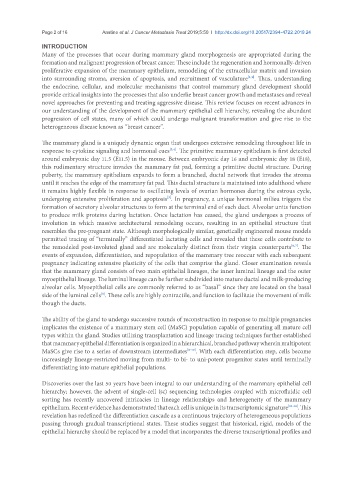Page 357 - Read Online
P. 357
Page 2 of 16 Anstine et al. J Cancer Metastasis Treat 2019;5:50 I http://dx.doi.org/10.20517/2394-4722.2019.24
INTRODUCTION
Many of the processes that occur during mammary gland morphogenesis are appropriated during the
formation and malignant progression of breast cancer. These include the regeneration and hormonally-driven
proliferative expansion of the mammary epithelium, remodeling of the extracellular matrix and invasion
[1,2]
into surrounding stroma, aversion of apoptosis, and recruitment of vasculature . Thus, understanding
the endocrine, cellular, and molecular mechanisms that control mammary gland development should
provide critical insights into the processes that also underlie breast cancer growth and metastases and reveal
novel approaches for preventing and treating aggressive disease. This review focuses on recent advances in
our understanding of the development of the mammary epithelial cell hierarchy, revealing the abundant
progression of cell states, many of which could undergo malignant transformation and give rise to the
heterogeneous disease known as “breast cancer”.
The mammary gland is a uniquely dynamic organ that undergoes extensive remodeling throughout life in
response to cytokine signaling and hormonal cues . The primitive mammary epithelium is first detected
[3,4]
around embryonic day 11.5 (E11.5) in the mouse. Between embryonic day 16 and embryonic day 18 (E18),
this rudimentary structure invades the mammary fat pad, forming a primitive ductal structure. During
puberty, the mammary epithelium expands to form a branched, ductal network that invades the stroma
until it reaches the edge of the mammary fat pad. This ductal structure is maintained into adulthood where
it remains highly flexible in response to oscillating levels of ovarian hormones during the estrous cycle,
undergoing extensive proliferation and apoptosis . In pregnancy, a unique hormonal milieu triggers the
[5]
formation of secretory alveolar structures to form at the terminal end of each duct. Alveolar units function
to produce milk proteins during lactation. Once lactation has ceased, the gland undergoes a process of
involution in which massive architectural remodeling occurs, resulting in an epithelial structure that
resembles the pre-pregnant state. Although morphologically similar, genetically engineered mouse models
permitted tracing of “terminally” differentiated lactating cells and revealed that these cells contribute to
the remodeled post-involuted gland and are molecularly distinct from their virgin counterparts . The
[6,7]
events of expansion, differentiation, and repopulation of the mammary tree reoccur with each subsequent
pregnancy indicating extensive plasticity of the cells that comprise the gland. Closer examination reveals
that the mammary gland consists of two main epithelial lineages, the inner luminal lineage and the outer
myoepithelial lineage. The luminal lineage can be further subdivided into mature ductal and milk-producing
alveolar cells. Myoepithelial cells are commonly referred to as “basal” since they are located on the basal
side of the luminal cells . These cells are highly contractile, and function to facilitate the movement of milk
[8]
though the ducts.
The ability of the gland to undergo successive rounds of reconstruction in response to multiple pregnancies
implicates the existence of a mammary stem cell (MaSC) population capable of generating all mature cell
types within the gland. Studies utilizing transplantation and lineage tracing techniques further established
that mammary epithelial differentiation is organized in a hierarchical, branched pathway wherein multipotent
MaSCs give rise to a series of downstream intermediates [8-10] . With each differentiation step, cells become
increasingly lineage-restricted moving from multi- to bi- to uni-potent progenitor states until terminally
differentiating into mature epithelial populations.
Discoveries over the last 50 years have been integral to our understanding of the mammary epithelial cell
hierarchy; however, the advent of single-cell (sc) sequencing technologies coupled with microfluidic cell
sorting has recently uncovered intricacies in lineage relationships and heterogeneity of the mammary
epithelium. Recent evidence has demonstrated that each cell is unique in its transcriptomic signature [11-14] . This
revelation has redefined the differentiation cascade as a continuous trajectory of heterogeneous populations
passing through gradual transcriptional states. These studies suggest that historical, rigid, models of the
epithelial hierarchy should be replaced by a model that incorporates the diverse transcriptional profiles and

